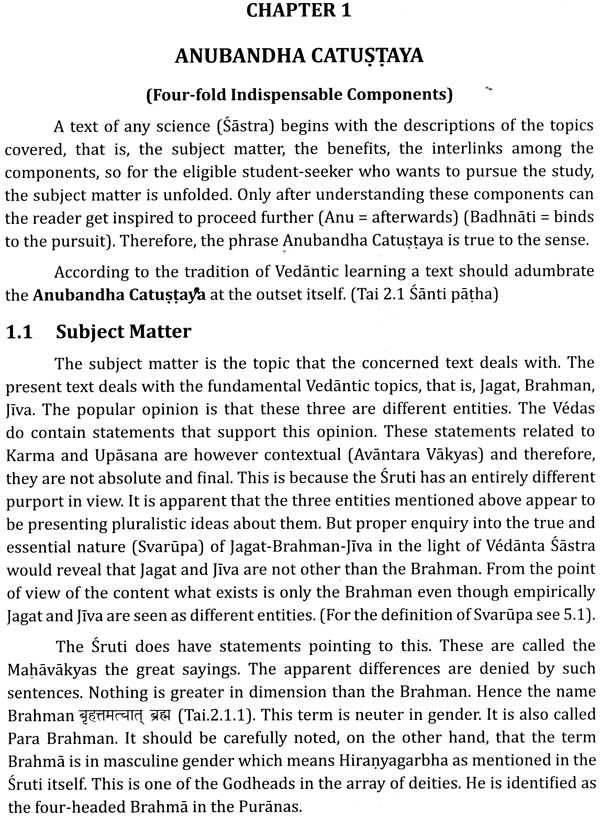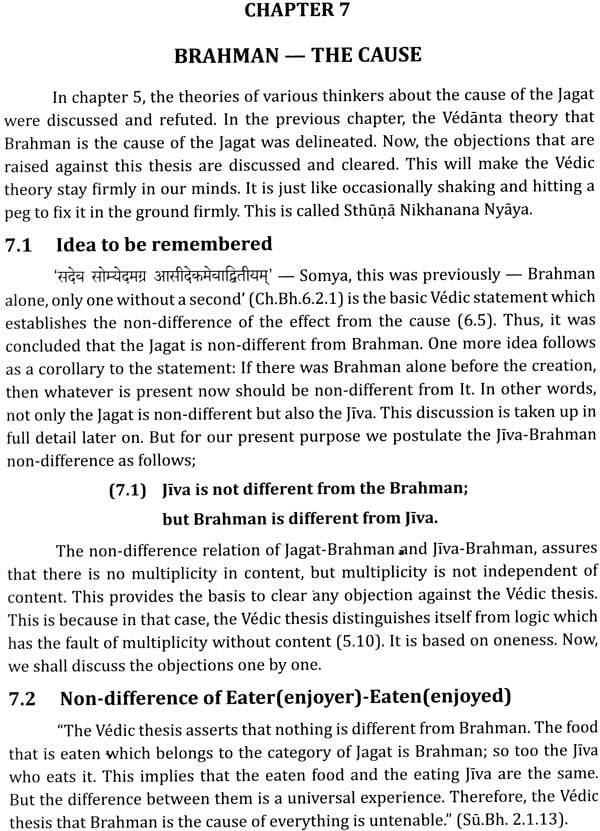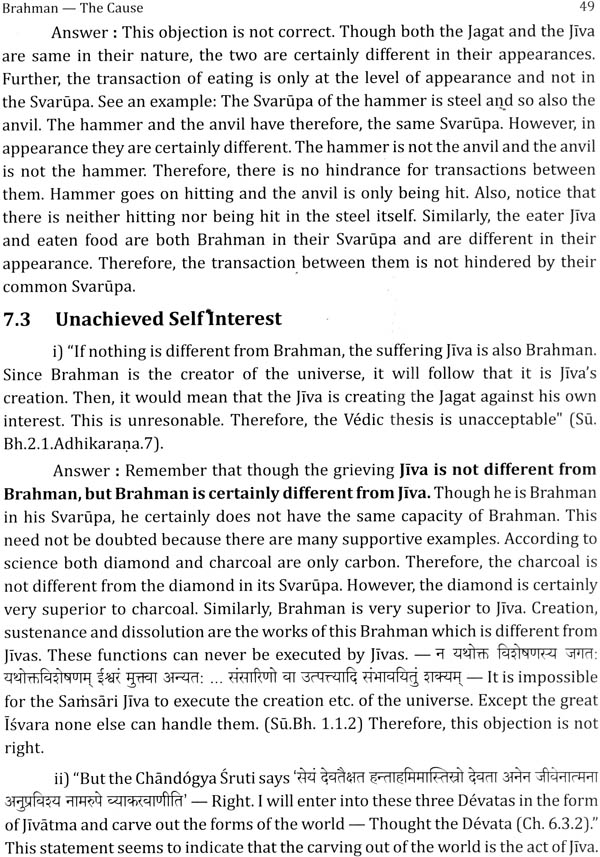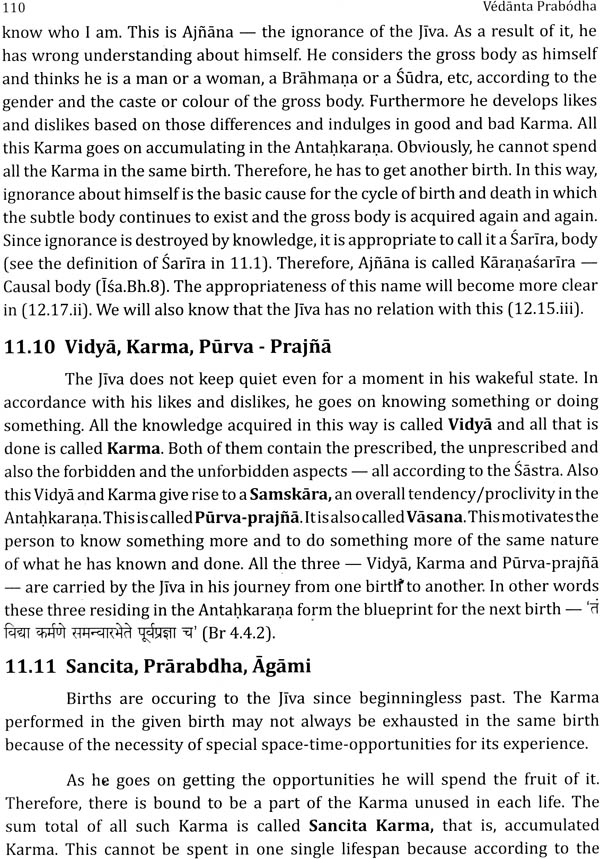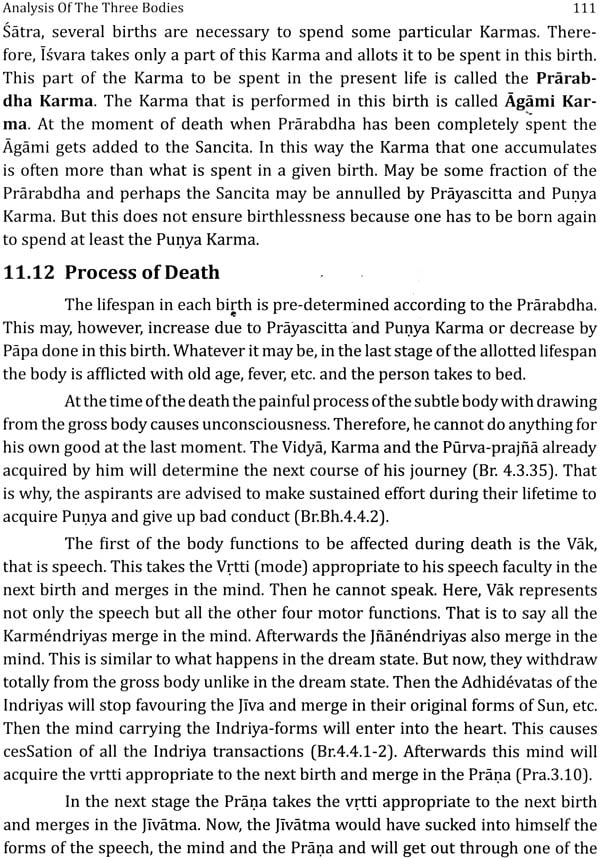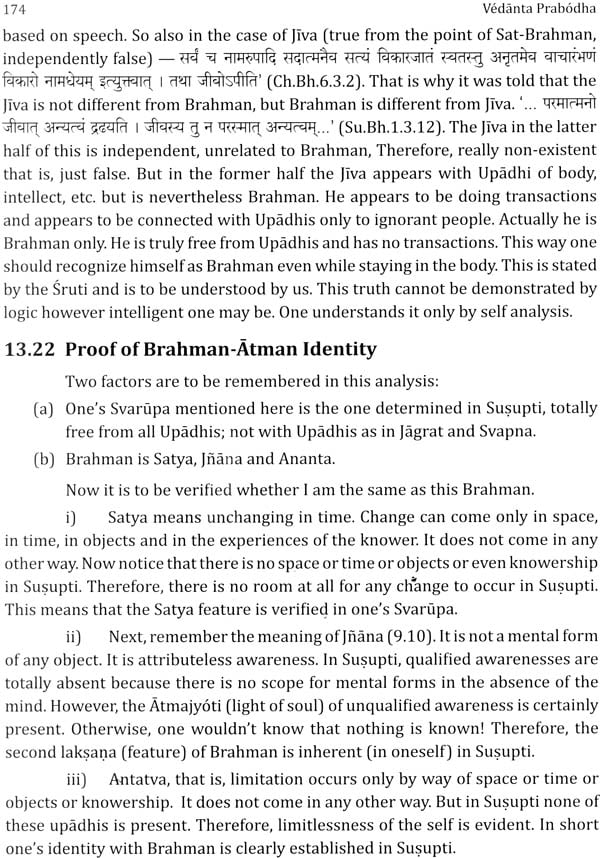
Vedanta Prabodha - The Most Exhaustive Book Ever Written on Shankaracharya's Advaita Vedanta
Book Specification
| Item Code: | NAG842 |
| Author: | Swami Paramananda Bharati |
| Publisher: | JNANASAMVARDHANI PRATISHTHANAM |
| Language: | English |
| Edition: | 2019 |
| Pages: | 278 |
| Cover: | Paperback |
| Other Details | 9.5 inch X 7.0 inch |
| Weight | 530 gm |
Book Description
How is one to begin the study of Vedanta? What are the benefits of studying Vedanta? have been the intriguing questions one faces in life. The universe is limitless, unimaginably complex and variegated. "Whence it has come? Why it has come? What exactly is it's intrinsic nature?" are questions that spontaneously arise in the mind of the observer. They are not answerable by inference as known to Science. It is only the Vedas-Vedanta that can answer them.
The opening chapters in this book (Anubandha Chatustaya, Sadhana Chatustaya, Guru, and Pramanas) will reinforce the readers' ardent interest with basic constructs required for a disciplined study of Vedanta, The detailed discussions in the chapters will not "only provide the reader with good clarity about the procedure to study Vedanta but also clarify the ultimate benefit of studying Vedanta. Vedas say unequivocally, that the Brahman is the ultimate cause of the Universe and is the one without a second. It is absolutely indescribable.
The extensive discussions in the chapters on Jagat, Brahman, Jiva, Moksha and Sadhana Prakaranam, enumerates the quintessential parameters required to actually realize that Brahman is the ultimate cause of the universe. In each aeon called Kalpa, the universe is born out of Brahman, lives in Brahman and dissolves in Brahman. Therefore, Brahman is the intrinsic nature of the universe. The universe is changing-Asatya, but Brahman is unchanging-Satya. It goes even beyond and says that the observer of the universe is himself Brahman and one who realizes it attains total freedom from all bondage.
The detailed chapters on Maya and Avidya carefully clarifies that Maya [Prakrti] is Brahman's intrinsic power by which It assumes the form of the universe for the benefit of Jivas and thereby repudiates the hardened perception that Maya and Avidya are synonyms; also that the Universe is an Illusion-Mithya! A pragmatic clarification is given to the confusion about "Mithya Jagat" in the discussion.
Bhagavan Sankara has written the Prasthanatraya Bhasyas elucidating this thesis. The presentation of Bhagavan Sri Sankara's description of the universe as Mithya-Anirvacaniya-Asatya at three different levels of teaching invokes and at the same time provokes the prime attention of the reader. These adjectives are exclusively different. Thinking that they refer to the same idea, some people have stuck to the adjective Mithya and then tried to reconcile the other two with it using logic that is sometimes funny and sometimes exasperating. Nothing in the Bhasyas needs to be reconciled by devious logic. Bhasyas are already complete, immaculate and unambiguous. The authentic content in this book maintains thorough compliance to references from the Vedas and Bhagavan Sri Sankara's Prasthanatraya Bhasyas. This book exhibits the seamlessness of Sri Sankara's presentation, which .. helps the reader to plunge into Sadhana with conviction.
As a special mention, Jasjit Mansingh, an acclaimed author deserves credit for shaping this English edition aesthetically and with immense proof reading while also adding valuable corrections to the English vocabulary used in the book. Her selfless devotion and dedication in preparing the book for publishing is highly commendable.
Possessed with the responsibility to bring out this new edition of Vedanta Prabodha in its present form, Chi.Srihari has ardently striven to meet the expectations at various levels during proof reading, and editing, thus making the script error free for publishing.
My prayers to lord Narayana to bless one and all with good health, prosperity and peace.
Contents
| Author's Note for the new edition | xv-xvi | |
| The Essential Teachings of Adya Sankaracarya | xviii-xxi | |
| What did Sankara Really Teach? | xxii-xxvii | |
| Dedication | 1 | |
| Introductory Prakaranam | 2 | |
| Chapter 1 | Anubandha Catustaya | 3-6 |
| Subject Matter | ||
| Benefit | ||
| The Linkage | ||
| Adhikari - the eligible student seeker | ||
| Chapter 2 | Sadhana Catustaya Sampatti | 7-11 |
| Nitya-Anitya Vastu Viveka | ||
| Dispassion | ||
| Samadi Satka | ||
| Mumuksutva | ||
| One Doubt | ||
| Who are all entitled for Moksa? | ||
| Chapter 3 | Guru | 12-15 |
| The need for a Guru | ||
| Characteristics of a Guru | ||
| How to get the Sadguru? | ||
| Service to the Guru | ||
| A word of caution | ||
| Chapter 4 | Pramana- Means of Knowledge | 16-23 |
| Triputi: Three fold factors | ||
| Pratyaksa Pramanam: Sense Perception as a means | ||
| Anumana Pramanam: Inference as a means | ||
| Upamana Pramanam: Analogy as a means | ||
| Arthapatti Pramanam: Presumption as a means | ||
| Agama Pramanam: Word ofGodlVerbal Testimony as a means | ||
| Another Pramana of the Mimamsakas | ||
| Jagat Prakaranam | 24 | |
| Chapter 5 | Other Theories | 25-36 |
| An Unperceived Cause of the Jagat exists | ||
| Three causes | ||
| Buddhists view | ||
| Mimamsaka's Logic | ||
| Vaisesikas's Theory | ||
| Naiyyayika's Theory | ||
| Sankhya Thesis | ||
| Modem Arguments | ||
| The Role of Logic in this discussion | ||
| The Limitations of Logic | ||
| The complete Logic | ||
| Chapter 6 | The Vedic Theory | 37-47 |
| Brahman is the Nimitta of the Jagat | ||
| Brahman is the Up adana Karana of the Jagat | ||
| Upadana or Antaryamin? | ||
| Vacarambhana - Namadheya | ||
| Cause-Effect Non-difference | ||
| Chapter 7 | Brahman - The Cause | 48-58 |
| Idea to be remembered | ||
| Non-difference of Eater (enjoyer) - Eaten (enjoyed) | ||
| Unachieved SelfInterest | ||
| Objection that Brahman has no Sahakari | ||
| The objection that the Brahman has no limbs | ||
| Objection of Purposelessness of Creation | ||
| Is the Brahman biased and cruel? | ||
| Objection regarding distinctiveness | ||
| Can inert objects come out of Cetana? | ||
| Whose thesis is to be accepted? | ||
| Objection of Brahman having parts | ||
| Upadhi | ||
| Chapter 8 | Maya | 59-70 |
| The example | ||
| What is Maya? | ||
| Synonyms of Maya | ||
| Apara and Para Prakrtis | ||
| Maya Subservient to Brahman | ||
| Four- faced Brahma | ||
| Process of Creation | ||
| Dissolution | ||
| Maya is Eternal | ||
| Maya is Anirvacanrya | ||
| Maya is non-different from Brahman | ||
| Summary of Jagat Prakaranam | 71 | |
| Brahma Prakaranam | 72 | |
| Chapter 9 | Brahman, Separate From The Jagat | 73-84 |
| Visesana - Laksana | ||
| The Existent Attributes | ||
| Non-existent attributes | ||
| Brahman is Satya | ||
| The Illusory Wodd | ||
| Three Satyas | ||
| Lens example | ||
| Transcendental Satya | ||
| Transactional Satya | ||
| Virtual Satya | ||
| Brahman is Jnana | ||
| Is Brahman Sarvajfia or Not? | ||
| Brahman is Ananta | ||
| The Experience of the Jnana | ||
| The Experience of the Jnana | ||
| Chapter 10 | The Attributelles Brahman | 85-96 |
| The Unqualified Brahman | ||
| The Reason for Brahman's Featurelessness | ||
| Is the Jagat Existent or Non-existent? | ||
| Doubt Regarding two imaginations | ||
| Adhyaropa-Apavada | ||
| Summary of Brahmaprakaranam | 97 | |
| Jiva Prakaranam | 98 | |
| Chapter 11 | Analysis of the Three Bodies | 99-112 |
| Gross Body | ||
| The Gross Body is not me | ||
| Subtle Body | ||
| The Five Pranas | ||
| The Antahkarana | ||
| The Five Jfianendriyas | ||
| The Five Karrnendriyas | ||
| The Subtle body is not me | ||
| Causal Body | ||
| Vidya Karma Piirva Prajfia | ||
| Sancita, Prarabdha, Agami | ||
| Process of Death | ||
| The Process of Rebirth | ||
| Chapter 12 | Avidya | 113-157 |
| JIva's wrong identification | ||
| Where else to find Jiva Svarupa? | ||
| Determination of the Svariipa | ||
| Agama's Answer | ||
| Is Jiva an Amsa of Brahman? | ||
| Definition of Avidya and Adhyasa | ||
| Effect of Maya is the support of Adhyasa | ||
| Adhyasa is the cause of danger | ||
| Is Avidya an existent entity or merely absence of Vidya? | ||
| Buddhi is Dharmi, Vidya is Pratiygi | ||
| Avidya is beginningless | ||
| Avidya is endless | ||
| Avidya belongs to whom? Maya belongs to whom? | ||
| Motivaton for Creation comes from Avidya | ||
| The Meaning of the Word Avidyakalpita Illusion | ||
| Avidya Laksana Prakrti | ||
| Avidyatrnika Hi Blja Saktih | ||
| Which is the cause of Jagat - Maya or Avidya? | ||
| The two examples | ||
| Maya and A vidya not synonymous | ||
| Chapter 13 | Jagrat, Svapna and Susupti | 158-182 |
| Wakefulness | ||
| Jyoti | ||
| What is Svapna? | ||
| The Dream Jagat | ||
| Dream: Junction of the worlds here and hereafter | ||
| Who creates Dreams? | ||
| Does Jy6ti Belong to the body? | ||
| Svapna Jyoti- Not of the body | ||
| Jyoti is of the Atman | ||
| Qualified Jfiana is Through Indriyas | ||
| Atman is Not unknown | ||
| The Facility with Dreams | ||
| Susupti | ||
| Where is the Jiva in Susupti? | ||
| The Non-dual State | ||
| This is Paramananda (Highest Bliss) | ||
| Analysis of Ananda | ||
| The levels of Ananda | ||
| The Nature of grief | ||
| One's Svarupa is the same as in Susupti | ||
| One's Identity with Brahman | ||
| Proof of Brahman-Arman Identity | ||
| Why not qualified awareness? | ||
| Unwareness of even oneself | ||
| An example | ||
| The question of Avidya in Susupti | ||
| Objections for Avidya's non-existence | ||
| A vidya exists, but not Adhyasa in Susupti | ||
| Chapter 14 | Turiya | 183-203 |
| Saksi | ||
| Sankhya-Yoga | ||
| Right Realization is Sarvatamabhava | ||
| Examples | ||
| Sublimation of the world | ||
| Samasti- Vyasti | ||
| Vaisvanaratma | ||
| Taijsatrna | ||
| Prajfiatma | ||
| Turiya | ||
| Some doubts | ||
| Omkara | ||
| Chapter 15 | The Analysis of Five Sheaths | 204-212 |
| Transactions in Vyasti | ||
| The Nature of the Analysis | ||
| Annamayatma (Vya~ti) | ||
| Pranamayatma (Vyasti) | ||
| Manomayatma (Vyasti) | ||
| Vijfianamayatma (Vyasti) | ||
| Anandamayatma (Vyasti) | ||
| Upasafikramana of Samasti Atmans | ||
| Ananda-Anandl | ||
| Upasana Meditation on Sarnasti Atma | ||
| Summary of Jiva Prakaranam | 213 | |
| Sadhana Prakaranam | 214 | |
| Chapter 16 | Moksa | 215-219 |
| What is Moksa? | ||
| Moksa is only through Jfiana | ||
| Jnana is not a result of Karma | ||
| Chapter 17 | Sannyasa | 220-226 |
| Veda permits Sannyasa | ||
| Vidvat Sannyasa | ||
| Karma of Jnani | ||
| Vividisa Sannyasa | ||
| The rules of Vividisa Sannyasa | ||
| Slipping from Sannyasa | ||
| Chapter 18 | Upasana | 227-229 |
| What is Upasana? | ||
| Relation with Alambana | ||
| Upasana of Pratika | ||
| Chapter 19 | Karma | 230-238 |
| Feature of the Veda | ||
| The Creation of Varnas | ||
| Varna Dharma | ||
| Asrama Dharma | ||
| Karma | ||
| Can Karma lead to Moksa? | ||
| Path of Moksa - One or Several? | ||
| Bhakti | ||
| Summary of Sadhana Prakaranam | 239 | |
| Epilogue | 240-246 | |
| Index | 247-251 |
